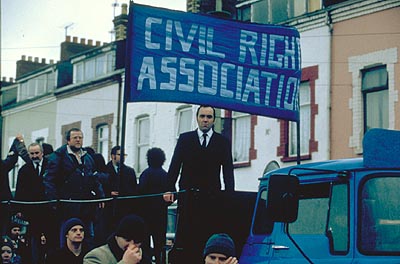

On January 30, 1972, British soldiers opened fire on a march in the town of Derry, killing 13 Irishmen and injuring many others. Many people consider this the event that started over a quarter century of violence between the IRA and the British. The events depicted in Bloody Sunday were also immortalized in the U2 song "Sunday Bloody Sunday," and continue to have political reverberations even to this day. Bloody Sunday powerfully traces the fateful and controversial events of that one day from both sides. The film won the Audience Award at the 2002 Sundance Film Festival as well as tied for the Golden Bear Award (with Spirited Away) at the 2002 Berlin Film Festival.
The brunt of the power of Paul Greengrass' (The Theory of Flight, The Murder of Stephen Lawrence) film comes from the way he filmed Bloody Sunday with a handheld camera. The drawback is that sometimes the images are too shaky and the sound too garbled to understand anything. However, Greengrass does this so adroitly that it feels like the audience is right in the middle of the march. The chaos and confusion present is instantly palpable. When the crowd runs for cover, the cameraman runs, the camera jerks up and down, and it feels like the audience is running along in panic with the crowd. In meetings, it feels like one is looking over the shoulder of the person in front, trying to get a better glimpse of the speaker.
Bloody Sunday begins somewhat innocently, with Ivan Cooper (James Nesbitt, Lucky Break, Wild About Harry), an Irish member of Parliament, going about trying to organize a peaceful march. He fully believes in the ideals of Martin Luther King Jr., and feels that they can make an important political statement without violence. It is their right and their duty to march. He is seemingly everywhere at once, in each street, asking friends to participate in the march and pleading with soldiers to let him through. It is a different sort of confusion that exists at the beginning. Cooper is trying to pull various groups together, so that as one, they can do more. However, everywhere that Cooper goes, there are ominous portents present. Greengrass switches between Cooper and the preparations of the British forces, including Major General Ford (Tom Pigot-Smith, The Four Feathers, Innocents). It seems that some of the British are itching for confrontation. They have contingency plans in place along various parts of the proposed route.
As the march progresses, tensions begin to flare. Along with peaceful marchers there are people who want to incite violence, and the tug-of-war between the two factions does not end well. A sense of chaos begins to spread as well as a growing sense of inevitability and helplessness. Try as he might, Cooper is powerless to do anything to stop the violence. Greengrass sweeps the viewer into the melee, putting his camera in the middle of the danger. Incidents of violence cascade into a truly dangerous situation, and the movie ends with completely opposite statements by Ford and Cooper. Greengrass' depiction of the events of Bloody Sunday are truly moving. They force people everywhere to remember what happened by taking them right into the middle of it all.